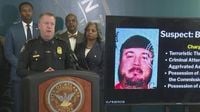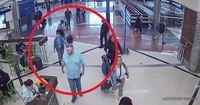On Monday morning, October 20, 2025, what could have been a devastating tragedy at Hartsfield-Jackson Atlanta International Airport was averted thanks to the swift actions of law enforcement—and, crucially, the vigilance of a concerned family. The suspect, identified as 49-year-old Billy Joe Cagle of Cartersville, Georgia, was arrested inside the airport after allegedly threatening to "shoot up" the terminal, according to multiple law enforcement agencies and officials.
Authorities say the chain of events began when Cagle livestreamed on social media early Monday, announcing his intention to head to Atlanta’s main airport and "shoot it up." Family members, alarmed by his words and aware of his history, immediately contacted Cartersville Police. As reported by ABC News, the family told officers that Cagle was in possession of a semi-automatic assault rifle and was on his way to the airport. Cartersville Police Captain Greg Sparacio later stated that the family said Cagle "had the intention to do harm to as many people as he could."
Acting quickly, Cartersville Police relayed the threat to the Atlanta Police Department around 9:40 a.m., providing a photo of Cagle and a description of his Chevrolet flatbed pickup truck. Atlanta Police Chief Darin Schierbaum told reporters that Cagle arrived at the airport at 9:29 a.m. and entered the South Terminal through door S1 at 9:31 a.m. Surveillance and bodycam footage showed Cagle walking through the terminal, appearing to scope out the TSA check-in area. Officers believe he was "scanning that area," potentially with the intention to return to his truck and retrieve his weapon.
Within minutes of receiving the alert, Atlanta officers located Cagle inside the crowded South Terminal. At 9:54 a.m.—less than 15 minutes after the initial notification—he was taken into custody without incident. Cagle was unarmed at the time, but officers soon discovered his white flatbed pickup truck parked just outside the terminal. Inside the vehicle, they found a Springfield AR-15 assault rifle loaded with one bullet in the chamber and 26 more in the magazine, for a total of 27 rounds of ammunition. Atlanta Police Chief Schierbaum later said, "I do believe he was likely to use that weapon inside the crowded terminal."
The suspect, described by authorities as a convicted felon with mental health challenges, now faces a litany of charges: terroristic threats, criminal attempt to commit aggravated assault, possession of a firearm during the commission of a felony, and possession of a firearm by a felon. According to 11Alive and the Associated Press, Cagle has a criminal history, including a prior conviction for possession of marijuana more than two decades ago.
Officials from both Cartersville and Atlanta police departments, as well as federal agencies, emphasized that the family’s decision to "see something and say something" was instrumental in preventing a potential mass shooting. Chief Schierbaum praised the collaboration between the community and law enforcement, stating, "Because of the community—in this case, the family—as well as the joint collaboration of law enforcement, a tragedy was indeed averted." He added, "Today is how it should work. Community, law enforcement, dedicated men and women wearing the uniform and trained to respond when their community needs them."
Atlanta Mayor Andre Dickens echoed these sentiments, expressing gratitude for the quick response and the actions of Cagle’s family. "We're thankful to God and to good information and good intel and good people for this crisis being averted," Dickens said during a press briefing. He went on to note the broader context of gun violence and mental health, remarking, "We're experiencing across the nation and even in this city where guns and mental health together can be deadly. We're thankful this crisis was averted today." Dickens also observed that "twenty-seven or more lives could have been lost today," referencing the number of rounds found with the AR-15.
The rapid response was a coordinated effort. Officers Gibson and Banks were specifically thanked for their role in arresting Cagle, while Sgt. Jones was recognized for helping coordinate the flow of information as it came in. The FBI Atlanta is assisting in the ongoing investigation, and Homeland Security Secretary Kristi Noem stated, "I am thankful this individual was taken into custody by law enforcement before harming anyone." She added that her department is "in communication with our interagency partners."
Body camera footage released by Atlanta Police shows the tense moments leading up to Cagle’s arrest. In the video, officers approach Cagle, who is wearing a blue polo shirt, as he walks through the terminal. When asked why he was there, Cagle replied, "I'm just here, why?" After further questioning, officers detained him. Cagle was reportedly screaming during the arrest but was unharmed and checked by EMS at the scene.
Authorities have not yet determined a specific motive for Cagle’s actions, and the investigation remains active. However, officials have confirmed that Cagle was in the midst of a mental health crisis. Police said they believe he was "probing the terminal before going back to his vehicle to commit an act of mass murder." The speed and clarity with which law enforcement responded—locating Cagle, arresting him, and securing the weapon—were widely praised as exemplary.
In the aftermath, law enforcement and city officials have highlighted this incident as a textbook example of how community vigilance and interagency cooperation can save lives. "This is a case where the family saw something and said something," Atlanta Police reiterated, crediting the family’s actions as crucial in stopping what could have been a "horrible act of violence."
The day’s events also unfolded against a backdrop of increased security concerns. On the same day, the Transportation Security Administration reported longer wait times at security checkpoints due to staffing shortages—the first such occurrence since the federal government shutdown began at the start of October. While unrelated, the coincidence served as a stark reminder of the challenges facing airport security and the importance of public vigilance.
As the investigation continues, the city of Atlanta is left reflecting on how close it came to tragedy—and how quickly it was averted. The story stands as a sobering illustration of the dangers posed by the intersection of mental health crises and easy access to firearms, but also as a testament to the power of community action and coordinated law enforcement response. For now, Atlanta’s busiest airport remains just that—busy, but safe, thanks to the people who acted when it mattered most.






